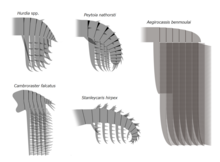Hurdiidae
| Hurdiidae Temporal range:
| |
|---|---|

| |
| Stanleycaris (top left), Hurdia (top right), Aegirocassis (middle), Peytoia (bottom left), Cambroraster (bottom right) | |
| Scientific classification | |
| Domain: | Eukaryota |
| Kingdom: | Animalia |
| Phylum: | Arthropoda |
| Class: | †Dinocaridida |
| Order: | †Radiodonta |
| Family: | †Hurdiidae Vinther et al., 2014 |
| Genera | |
|
See text | |
Hurdiidae (synonymous with the previously named Peytoiidae period.
Description



Hurdiidae is characterized by frontal appendages with distal region composed of 5 subequal blade-like endites, alongside the enlarged head carapaces and tetraradial mouthpart (oral cone).[2]
The frontal appendages of hurdiids have a distinctive morphology, with the appendage of most species bearing five equally-sized elongate blade-like ventral spines known as endites.[3] Subsequent podomeres were reduced in size and with only small endites or none. Each podomere bore only a single endite, unlike other radiodonts, in which the endites were paired.[3] In most species, the endites were curved medially, so that the appendages formed a basket-like structure.[2] Some hurdiids had greater numbers of endites, with Cordaticaris bearing seven endites of equal length.[4] Ursulinacaris is unique among hurdiids in bearing paired endites, which is likely a transitional form between the appendage of other radiodonts and that of hurdiids.[3]
Hurdiids exhibited a wide range of body size. The smallest known hurdiid specimen, of an unnamed species, is estimated to have had a body length of 6–15 millimetres (0.24–0.59 in), but it is not known whether this specimen was juvenile or adult.[5] Aegirocassis, the largest known hurdiid, was over 2 metres (6.6 ft) long, comparable in size to the largest known arthropods.[6]
Paleobiology
The majority of hurdiids appear to have been predators that fed by sifting sediment with their frontal appendages, but some members, like Aegirocassis, Pseudoangustidontus, and possibly Cambroraster were suspension feeders.[2][7][8]
Distribution
Hurdiids had a global distribution.[4] The earliest known hurdiid in the fossil record is Peytoia infercambriensis, which lived during the third age of the Cambrian in what is now the country of Poland.[9] The group increased in diversity during the Miaolingian epoch.[4] Post-Cambrian records of the group are rare, but the group lasted into the Devonian period, with the last known taxon being the Emsian Schinderhannes bartelsi from what is now Germany.[9][5]
Classification
Hurdiidae is classified within
The phylogeny of hurdiids, accompanying the description of the hurdiids Aegirocassis benmoulae, Titanokorys gainesii, and the analyzation of Stanleycaris hirpex as follows:[6]
| Phylogenetic position of hurdiid radiodonts after Moysiuk & Caron 2022.[11] |
Species include
- Buccaspinea cooperi[12]
- Cambroraster falcatus[13]
- Cordaticaris striatus[13]
- Hurdia triangulata[13]
- Hurdia victoria[13]
- Hurdia hospes[14]
- Huangshandongia yichangensis [15]
- Liantuoia inflata[15]
- Pahvantia hastata[13]
- Peytoia nathorsti[13]
- Peytoia infercambriensis[3]
- Schinderhannes bartelsi[13]
- Stanleycaris hirpex[13]
- Titanokorys gainesii[13]
- Ursulinacaris grallae[3]
- Zhenghecaris shankouensis?[13]
- Aegirocassisinae
References
- ^ S2CID 266292707.
- ^ PMID 31362637.
- ^ PMID 31210962.
- ^ S2CID 224868404.
- ^ PMID 32742697.
- ^ S2CID 205242881.
- PMID 34284622.
- ^ .
- ^ S2CID 130745134.
- S2CID 205237459.
- S2CID 250361698.
- ^ Pates S, Lerosey-Aubril R, Daley AC, Kier C, Bonino E, Ortega-Hernández J. 2021. The diverse radiodont fauna from the Marjum Formation of Utah, USA (Cambrian: Drumian) PeerJ 9:e10509 https://doi.org/10.7717/peerj.10509
- ^ PMID 34527273.
- ^ Chlupač, Ivo; Kordule, Vratislav (2002). "Arthropods of Burgess Shale type from the Middle Cambrian of Bohemia (Czech Republic)". Bulletin of the Czech Geological Survey. 77 (3): 167–182.
- ^ a b Zhilin, Cui; Shicheng, Huo (1990). "鄂西下寒武统甲壳类化石新发现". Acta Palaeontologica Sinica.







